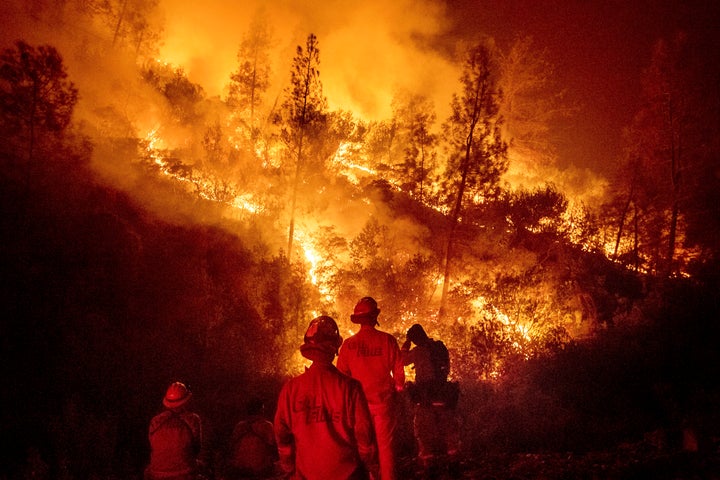It’s no secret where the Trump administration stands on studying and combating climate change: “We’re not spending money on that anymore,” Mick Mulvaney, director of the Office of Management and Budget, said at a White House briefing last year. “We consider that to be a waste of your money to go out and do that.”
As President Donald Trump continues to dismiss the all-but-irrefutable scientific consensus on climate change, federal reports released last week make it clear that failing to rein in greenhouse gas emissions will cost the United States far more in the long run than tackling the crisis head-on.
As part of the historic 2015 Paris climate accord, nearly 200 countries committed to helping prevent global temperatures from increasing by 2 degrees Celsius, the “magic number” scientists say would stave off the worst effects of climate change.
Overhauling U.S. energy infrastructure to reduce emissions by 80 percent below 2005 levels by the middle of the century ― a goal consistent with the 2-degree target ― would cost the United States between $1 trillion and $4 trillion (in 2005 U.S. dollar values) by mid-century, according to the 2018 State of the Carbon Cycle Report.
It might seem like a high price, but at worst, it’s on par with what it cost to run the federal government during fiscal year 2018 ― a projected $4.1 trillion — and, at best, far less.
“The bottom line is we can do this,” said Peter J. Marcotullio, a geography professor at City University in New York and the lead author of the report’s chapter on energy systems. “However, we cannot do it just on technology alone. We need policy.”
Policy like fuel economy standards, he said, which the Trump administration has proposed rolling back to allow vehicles to spew more carbon dioxide.

The State of the Carbon Cycle Report, issued by the U.S. Global Change Research Program, analyzes the carbon cycle across North America and is authored by more than 200 scientists from the U.S., Canada and Mexico. It draws upon studies over the last decade, with the $1 trillion to $4 trillion cost estimate coming from a 2014 study by Stanford University’s Energy Modeling Forum. Accounting for inflation, that’s between approximately $1.3 trillion and $5.1 trillion in today’s currency.
Marcotullio noted that the costs, which would be spread out over more than three decades, don’t account for the impact such a massive decarbonization effort could have on the economy. The Stanford report found that an emission reduction of 80 percent would result in a 3 to 5 percent loss in gross domestic product. But the price tag also doesn’t account for the many cost-saving co-benefits that would come from slashing emissions, including reduced damage to infrastructure and improved air quality.
The report highlights how investment in energy infrastructure would offset some, if not all, climate-related damages expected under a business-as-usual scenario with no mitigation of greenhouse gas emissions. Those damages are forecast to reach between $170 billion and $206 billion per year by 2050, depending on whether emissions are cut or continue business-as-usual, a 2017 study by the Environmental Protection Agency found.
Of course, averting catastrophic climate change requires swift, aggressive global action.
“A key takeaway of the report is that through a combination of technological advances and policy changes, it is possible for the U.S. to mitigate its share of global emissions.”
Katharine Hayhoe, a co-author of the climate assessment and director of the Climate Science Center at Texas Tech University, told HuffPost that the carbon cycle report, which she was not involved in, makes a clear economic argument for the Paris climate pact.
“There is no objective economic analysis that supports pulling out of the Paris Agreement if one’s time horizon is any longer than 20 years even under the most pessimistic view of the costs versus benefits,” Hayhoe wrote in an email. The report, she added, “highlights why anyone who cares about long-ranging planning and the long-term economic health and productivity of the U.S. would care: because it impacts our bottom dollar.”
The up-to-date carbon assessment details that while atmospheric carbon dioxide continues to soar, up 40 percent from pre-industrial levels, fossil fuel emissions in North America declined an average 1 percent per year between 2003 and 2014. Those reductions have been largely due to a shift from coal to cleaner-burning natural gas and the implementation of fuel economy standards.
A big uncertainty is what will happen to emission levels in North America over the next few decades, Marcotullio said. Forecasts suggest that by 2040, they could increase by more than 10 percent or decrease by more than 14 percent, according to the analysis. Nevertheless, a key takeaway of the report is that through a combination of technological advances and policy changes, it is possible for the U.S. to mitigate its share of global emissions.
“The problem is the longer you wait, the higher the price gets,” Marcotullio said.
The carbon cycle report and a chilling in-depth government climate report ― the Fourth National Climate Assessment ― were released on the Friday after Thanksgiving, a major shopping holiday, in a Trump administration move many saw as an attempt to bury the findings. The comprehensive documents add to the overwhelming scientific consensus that climate change is driven by human activity, is already affecting communities across the county and that the planet is barreling toward catastrophic, perhaps irreversible, change.
Along with plans to pull the U.S. out of the historic Paris climate pact, the Trump administration is pursuing an “energy dominance” agenda focused on boosting domestic fossil fuel production and working to roll back numerous environmental safeguards, including President Barack Obama’s Clean Power Plan, a policy limiting greenhouse gas emissions from power plants.

